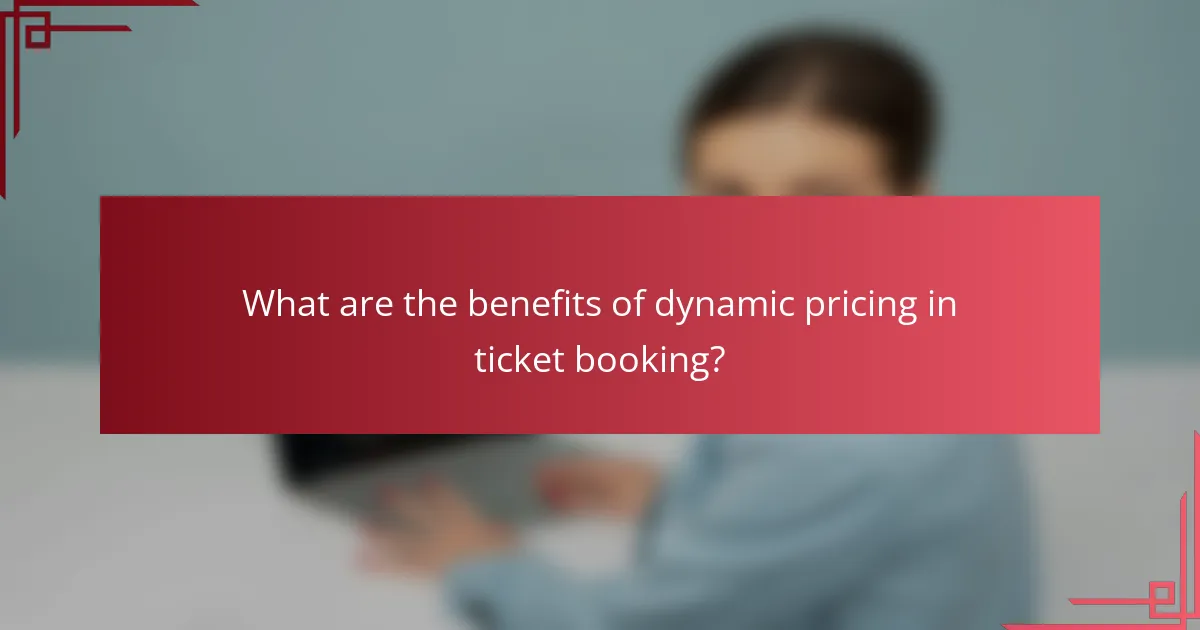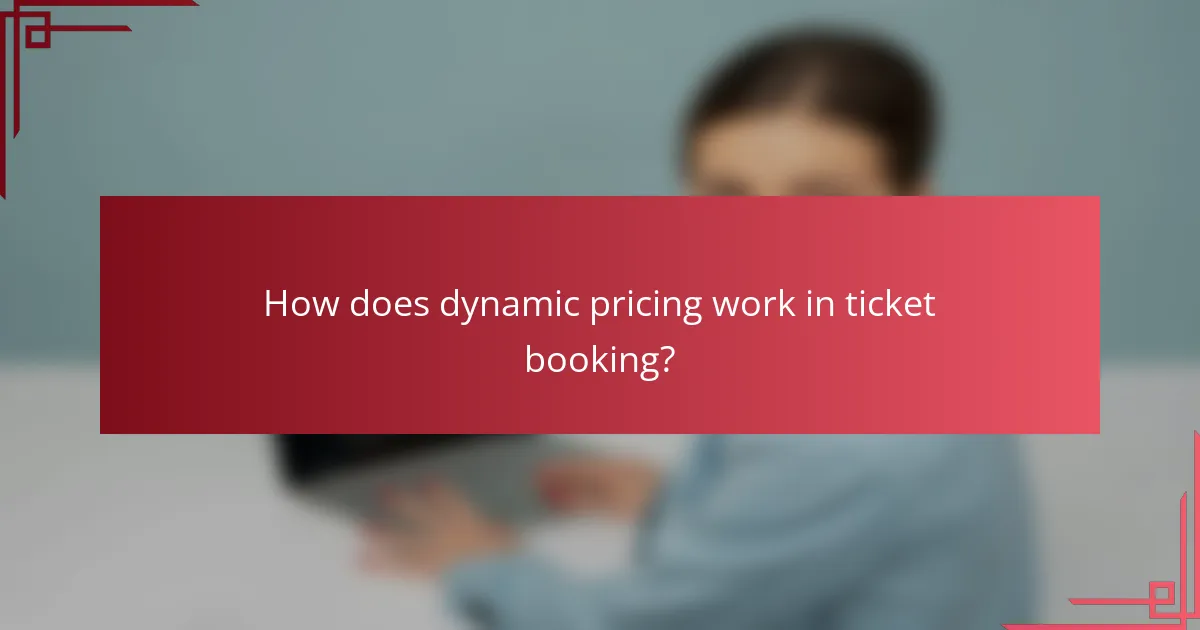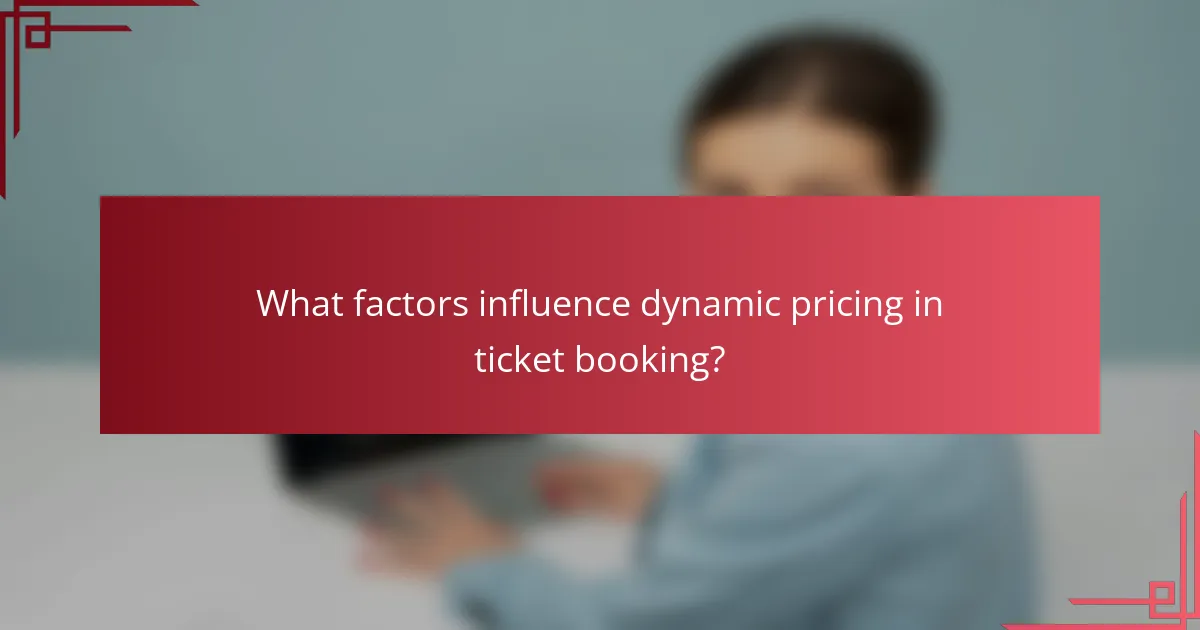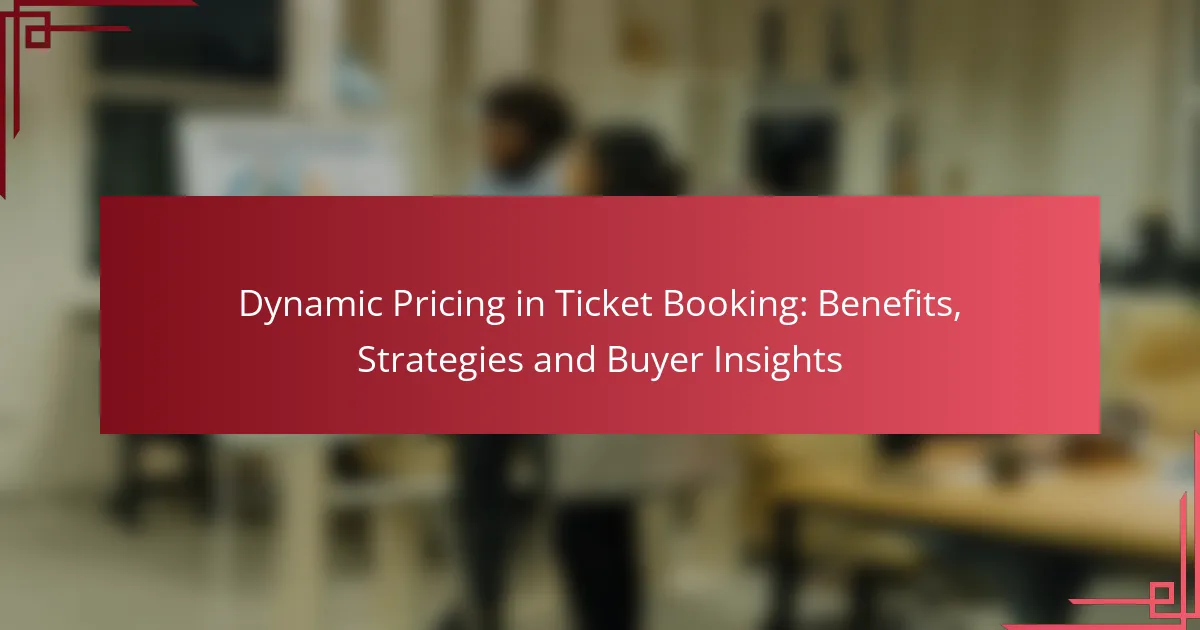Dynamic pricing in ticket booking is a strategy that enables companies to adjust prices in response to real-time demand, enhancing revenue potential and sales efficiency. By aligning ticket prices with market conditions and customer willingness to pay, this approach offers advantages for both sellers and buyers, ensuring a more responsive and optimized purchasing experience.

What are the benefits of dynamic pricing in ticket booking?
Dynamic pricing in ticket booking allows companies to adjust prices based on real-time demand, maximizing revenue and optimizing sales strategies. This approach benefits both sellers and buyers by aligning ticket prices with market conditions and customer willingness to pay.
Increased revenue potential
Dynamic pricing can significantly enhance revenue potential by enabling ticket sellers to capture higher prices during peak demand periods. For example, during major events or holidays, prices can rise substantially, allowing companies to benefit from increased consumer interest.
By analyzing historical data and current market trends, businesses can set prices that reflect the true value of their tickets, leading to improved profitability. Implementing this strategy effectively can result in revenue increases of 10-30% compared to static pricing models.
Enhanced customer segmentation
Dynamic pricing facilitates better customer segmentation by allowing sellers to tailor prices based on different buyer profiles. For instance, early bird discounts can attract budget-conscious customers, while premium pricing can target those willing to pay more for exclusive experiences.
This segmentation helps businesses understand their audience better and create targeted marketing campaigns, ultimately enhancing customer satisfaction and loyalty. By analyzing purchasing behavior, companies can refine their pricing strategies to meet diverse customer needs.
Improved inventory management
Dynamic pricing aids in effective inventory management by adjusting prices to optimize ticket sales and reduce unsold inventory. When demand is low, prices can be lowered to stimulate sales, while high demand can trigger price increases to maximize revenue.
This approach helps companies maintain a balanced inventory, ensuring that tickets are sold before the event date. By monitoring sales patterns, businesses can make informed decisions about pricing adjustments and inventory levels.
Real-time market responsiveness
Dynamic pricing allows sellers to respond quickly to market changes, such as competitor pricing or shifts in consumer demand. This real-time responsiveness ensures that ticket prices remain competitive and aligned with market conditions.
For example, if a rival event lowers its ticket prices, a company can adjust its own prices swiftly to retain customer interest. This agility is crucial in a fast-paced environment where consumer preferences can change rapidly.
Competitive advantage
Implementing dynamic pricing can provide a significant competitive advantage in the ticketing industry. Companies that utilize this strategy can attract more customers by offering prices that reflect current demand, setting them apart from competitors using static pricing.
Moreover, the ability to analyze and adapt to market trends positions businesses as leaders in the industry. By leveraging data analytics and customer insights, companies can continually refine their pricing strategies to stay ahead of the competition.

How does dynamic pricing work in ticket booking?
Dynamic pricing in ticket booking adjusts ticket prices based on real-time market demand, competition, and other factors. This approach allows sellers to maximize revenue by charging higher prices during peak demand and lowering them during slower periods.
Algorithm-driven pricing models
Algorithm-driven pricing models utilize complex mathematical algorithms to determine ticket prices. These models analyze various factors, including historical sales data, competitor pricing, and customer behavior, to set optimal prices. For example, a concert ticket may be priced higher as the event date approaches if demand is increasing.
These algorithms can be categorized into several types, such as rule-based, machine learning, and predictive analytics. Each type has its strengths, with machine learning models often providing more accurate predictions by continuously learning from new data.
Data analysis for demand forecasting
Data analysis plays a crucial role in demand forecasting for ticket sales. By examining past sales trends, seasonal patterns, and external factors like holidays or major events, ticket sellers can predict future demand. For instance, a sports event may see increased ticket sales during playoff seasons compared to regular games.
Effective demand forecasting allows companies to adjust their pricing strategies proactively. Using tools like regression analysis or time series forecasting can help identify patterns and inform pricing decisions, ensuring that prices reflect current market conditions.
Real-time price adjustments
Real-time price adjustments enable ticket sellers to modify prices instantly based on current demand levels. This flexibility allows for quick responses to market changes, such as a sudden spike in interest for a particular event. For example, if a popular artist announces a surprise concert, ticket prices can be increased immediately to capitalize on the heightened demand.
However, implementing real-time adjustments requires robust technology and data integration. Companies must ensure their systems can handle rapid changes without causing customer confusion or dissatisfaction. Clear communication about pricing changes can help maintain customer trust and satisfaction.

What strategies can be used for dynamic pricing?
Dynamic pricing strategies adjust ticket prices based on various factors to maximize revenue and optimize sales. These strategies can include time-based, demand-based, competitor-based, and segmentation-based pricing, each tailored to specific market conditions and buyer behaviors.
Time-based pricing
Time-based pricing involves adjusting ticket prices according to the time remaining before an event. Prices may start low and increase as the event date approaches, encouraging early purchases while maximizing revenue from last-minute buyers. For example, a concert ticket might be priced at $50 three months in advance but rise to $100 a week before the show.
When implementing time-based pricing, consider setting clear deadlines for price changes and communicating these to potential buyers. This creates urgency and can drive sales, but be cautious of alienating customers who may feel pressured.
Demand-based pricing
Demand-based pricing adjusts ticket prices based on the current demand for an event. If an event is selling quickly, prices may increase, while slower sales could lead to discounts. For instance, if a sports game is nearly sold out, ticket prices might rise by 20% to capitalize on high demand.
To effectively use demand-based pricing, monitor sales trends and customer interest closely. Tools like analytics software can help identify patterns, but avoid overpricing, as this may deter potential buyers and lead to unsold tickets.
Competitor-based pricing
Competitor-based pricing sets ticket prices in relation to similar events or offerings in the market. If a rival concert is priced at $70, a similar event might be priced slightly lower to attract more buyers. This strategy requires regular market analysis to stay competitive.
When adopting competitor-based pricing, ensure that your value proposition is clear. If your event offers unique experiences or added benefits, it may justify a higher price point. Regularly review competitors’ pricing strategies to remain agile and responsive.
Segmentation-based pricing
Segmentation-based pricing involves tailoring ticket prices to different customer segments based on factors like age, location, or purchasing behavior. For example, offering discounted tickets for students or seniors can increase accessibility and boost attendance.
To implement segmentation-based pricing effectively, gather data on your audience and create targeted marketing campaigns. Be mindful of potential backlash from customers who may feel unfairly treated if they discover different pricing for similar tickets. Transparency in pricing strategies can help mitigate these concerns.

What factors influence dynamic pricing in ticket booking?
Dynamic pricing in ticket booking is influenced by several key factors, including event popularity, time until the event, seat location, and market trends. Understanding these elements can help both buyers and sellers navigate the pricing landscape effectively.
Event popularity
The popularity of an event significantly affects its ticket pricing. High-demand events, such as major concerts or sporting finals, often see ticket prices rise as the event date approaches. Sellers may employ dynamic pricing strategies to maximize revenue based on anticipated demand.
For example, a popular artist’s concert might see ticket prices increase by 20-50% as the event nears, especially if initial sales are strong. Buyers should monitor ticket prices early to identify trends and make informed purchasing decisions.
Time until the event
The time remaining until an event can greatly influence ticket prices. Generally, prices may start lower and gradually increase as the event date approaches, reflecting rising demand. However, this isn’t a strict rule; prices can drop if tickets remain unsold close to the event.
For instance, tickets for a concert might be priced at $50 three months out but could rise to $80 as the date approaches, or drop to $40 if sales are sluggish. Buyers should consider purchasing early for better deals but remain alert for last-minute price drops.
Seat location
Seat location is a crucial factor in dynamic pricing, as premium seats often command higher prices. Tickets closer to the stage or field typically cost more due to their desirability. Dynamic pricing adjusts these costs based on availability and demand for specific seating areas.
For example, front-row seats at a theater may sell for $150, while seats in the back might start at $70. Buyers should evaluate their seating preferences and budget, as investing in better seats can enhance the overall experience.
Market trends
Market trends, including competitor pricing and economic conditions, play a vital role in dynamic pricing strategies. Sellers often analyze competitor ticket prices and adjust their own accordingly to remain competitive. Economic factors, such as disposable income levels, can also influence pricing strategies.
For example, if a similar event in the area is priced lower, sellers may reduce their prices to attract buyers. Buyers should research comparable events and be aware of broader market conditions that could affect ticket prices, helping them secure the best deals.

How can buyers navigate dynamic pricing?
Buyers can effectively navigate dynamic pricing by staying informed about pricing trends and employing strategic timing for their purchases. Understanding how prices fluctuate based on demand and other factors can help consumers make better decisions and potentially save money.
Understanding pricing algorithms
Pricing algorithms analyze various data points, such as demand, time until the event, and competitor pricing, to adjust ticket prices dynamically. These algorithms can lead to significant price variations, often influenced by factors like seasonality and consumer behavior.
For instance, ticket prices may rise as an event date approaches or if demand spikes due to a popular performer. Buyers should be aware that algorithms may also offer lower prices during off-peak times or for less popular events.
Timing purchases strategically
Strategic timing is crucial when dealing with dynamic pricing. Generally, purchasing tickets well in advance or waiting until the last minute can yield different price outcomes. Early buyers may secure lower prices, while last-minute shoppers might find discounts if sellers aim to fill seats.
To maximize savings, consider monitoring prices regularly and setting alerts for specific events. Tools and apps that track price changes can help identify the best times to buy, ensuring you don’t miss out on potential deals.
